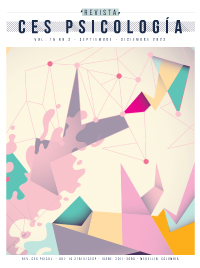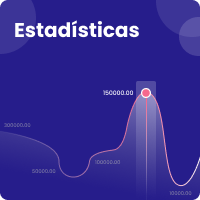Estudio psicométrico de la escala de Afecto Positivo y Negativo para niños y adolescentes (PANAS-N) en población mexicana
DOI:
https://doi.org/10.21615/cesp.6974Palabras clave:
bienestar psicológico, afecto, psicométrico, fiabilidad y validezResumen
La escala de Afecto Positivo y Negativo para niños y adolescentes (PANAS-N) es uno de los instrumentos más utilizados para la investigación en el ámbito de la psicología básica, positiva y clínica. El objetivo del presente trabajo fue estudiar las propiedades psicométricas, ofrecer datos descriptivos (media, desviación estándar y percentiles) e identificar posibles diferencias en las puntuaciones del PANAS-N, de acuerdo con el sexo y la edad en población mexicana. Se conformó una muestra de 1,047 estudiantes de secundaria (M=14.09; DE=2.29; 55.2% sexo femenino), a quienes se les aplicó la escala PANAS-N, la Escala de Depresión del Centro de Estudios Epidemiológicos CES-D y la Escala de Gaudibilidad para niños y adolescentes (EGNA) (moduladores del disfrute). Se corroboró la estructura interna de dos factores, Afecto Positivo (AP) y Afecto Negativo (AN) a través de un Análisis Factorial Confirmatorio (χ²(169) = 947.17; p<.001, CFI = .96, TLI = .95, RMSEA = .06, SRMR = .07) y los factores mostraron adecuados valores de consistencia interna (AP: α = .828 y w = .830, y AN: α = .819 y w = .820). Asimismo, las relaciones con las otras variables fueron las esperadas (AP correlación positiva y moderada con gaudibilidad, y AN correlación positiva con sintomatología depresiva), excepto la relación entre afecto positivo y sintomatología depresiva que no resultó significativa. La escala PANAS-N es un instrumento adecuado para evaluar el afecto positivo y negativo en población infantil y adolescente de la ciudad de Morelia (México).
Descargas
Referencias bibliográficas
Abad, F., Olea, j., Ponsoda, V., & García, C. (2011). Medición en ciencias sociales y de la salud. Síntesis.
Allan, N. P., Lonigan, C. J., & Phillips, B. M. (2015). Examining the factor structure and structural invariance of the PANAS across children, adolescents, and young adults. Journal of personality assessment, 97(6), 616-625. https://doi.org/10.1080/00223891.2015.1038388
Anderson, E. R., & Hope, D. A. (2008). A review of the tripartite model for understanding the link between anxiety and depression in youth. Clinical Psychology Review, 28(2), 275-287. https://doi.org/10.1016/j.cpr.2007.05.004
Asociación Médica Mundial. (2020, 25 de mayo). Declaración de Helsinki de la AMM – Principios éticos para las investigaciones médicas en seres humanos. https://www.wma.net/es/policies-post/declaracion-de-helsinki-de-la-amm-principios-eticos-para-las-investigaciones-medicas-en-seres-humanos/
Ato, M., López, J.J., & Benavente, A. (2013). Un sistema de clasificación de los diseños de investigación en psicología. Anales de Psicología 29(3), 1038-1059.
Bradburn, N.M. (1969). The structure of psychological well-being. Chicago: Aldine. https://doi.org/10.1017/s0033291700007637
Byrne, B. (2001). Structural equation modeling with Amos: Basic concepts, applications and programming. Erlbaum.
Casuso, L., Gargurevich, R., Van den Noortgate, W., & Van den Bergh, O. (2016). Psychometric properties of the positive and negative affect scale for children (PANAS-C) in Peru. Interamerican Journal of Psychology, 50(2), 170-185. https://www.redalyc.org/articulo.oa?id=28447010002
Ciucci, E., Baroncelli, A., Tambasco, G., Laurent, J., Catanzaro, S. J., & Joiner, T. E. (2017). Measuring Positive Affect, Negative Affect, and Physiological hyperarousal among Italian youth: translations of the PANAS-C and PH-C. Journal of Psychopathology and Behavioral Assessment, 39(3), 373-382. https://doi.org/10.1007/s10862-017-9596-8
Clark, L.A., & Watson, D. (1991). Tripartita model of anxiety and depression: Psycho- metrlc evidence and taxonomic implications. Journal of Abnormal Psychology, 100, 316-336. https://doi.org/10.1037/0021-843x.100.3.316
De Bolle, M., & De Fruyt, F. (2010). The tripartite model in childhood and adolescence: Future directions for developmental research. Child Development Perspectives, 4(3), 174-180. https://doi.org/10.1111/j.1750-8606.2010.00136.x
Diener, E. (1984). Subjetive Well-Being. Psychological Bulletin, 95(3), 542-575. https://doi.org/10.1037/0033-2909.95.3.542
Diener, E., Suh, E. M., Lucas, R. E., & Smith, H. L. (1999). Subjective well-being: Three decades of progress. Psychological Bulletin, 125(2), 276–302. https://doi.org/10.1037/0033-2909.125.2.276
Ebesutani, C., Okamura, K., Higa-McMillan, C., & Chorpita, B. F. (2011). A psychometric analysis of the Positive and Negative Affect Schedule for Children–Parent Version in a school sample. Psychological assessment, 23(2), 406-416. https://psycnet.apa.org/doi/10.1037/a0022057
Fava, M., Hwang, I., Rush, A. J., Sampson, N., Walters, E. E., & Kessler, R. C. (2010). The importance of irritability as a symptom of major depressive disorder: results from the National Comorbidity Survey Replication. Molecular psychiatry, 15(8), 856-867. https://doi.org/10.1038%2Fmp.2009.20
Gómez-Hernández, E., Carrillo-Ramírez, R., & Padrós-Blázquez, F. (2020). Propiedades psicométricas de la Escala para medir el Disfrute Experimentado en Niños y Adolescentes (EDENA) en población de Michoacán (México). Psicogente, 23(43), 1-18. https://doi.org/10.17081/psico.23.43.3761
González Arratia López Fuentes, N. I., & Valdez Medina, J. L. (2015). Validity of the positive and negative affect schedule (PANAS) in children. Liberabit. Revista Peruana De Psicología, 21(1), 37-47. http://ojs3.revistaliberabit.com/index.php/Liberabit/article/view/284
Gaudreau, P., Sanchez, X., & Blondin, J. P. (2006). Positive and negative affective states in a performance-related setting: Testing the factorial structure of the PANAS across two samples of French-Canadian participants. European Journal of Psychological Assessment, 22(4), 240-249. https://doi.org/10.1027/1015-5759.22.4.240
Hughes, A. A., & Kendall, P. C. (2009). Psychometric properties of the Positive and Negative Affect Scale for Children (PANAS-C) in children with anxiety disorders. Child Psychiatry and Human Development, 40(3), 343-352. https://doi.org/10.1007/s10578-009-0130-4
Jacques, H. A., & Mash, E. J. (2004). A test of the tripartite model of anxiety and depression in elementary and high school boys and girls. Journal of Abnormal Child Psychology, 32(1), 13-25. https://doi.org/10.1023/b:jacp.0000007577.38802.18
Jiménez-Tapia, A., Wagner, F., Rivera-Heredia, M. E., & González-Forteza, C. (2015). Estudio de la depresión en estudiantes de la Ciudad de México y del Estado de Michoacán por medio de la versión revisada de la CES-D. Salud Mental, 38(2), 103-107. https://doi.org/10.17711/SM.0185-3325.2015.014
Joiner Jr, T. E., Catanzaro, S. J., & Laurent, J. (1996). Tripartite structure of positive and negative affect, depression, and anxiety in child and adolescent psychiatric inpatients. Journal of abnormal psychology, 105(3), 401-409. https://doi.org/10.1037/0021-843x.105.3.401
Joiner, T. E., & Lonigan, C. J. (2000). Tripartite model of depression and anxiety in youth psychiatric inpatients: Relations with diagnostic status and future symptoms. Journal of Clinical Child Psychology, 29(3), 372-382. https://doi.org/10.1207/s15374424jccp2903_8
Kline, R. B. (2015). Principles and practice of structural equation modeling. Guilford publications
Laurent, J., Catanzaro, S. J., Joiner Jr, T. E., Rudolph, K. D., Potter, K. I., Lambert, S., Osborne, L., & Gathright, T. (1999). A measure of positive and negative affect for children: Scale development and preliminary validation. Psychological assessment, 11(3), 326-338. https://doi.org/10.1037/1040-3590.11.3.326
Lonigan, C. J., Phillips, B. M., & Hooe, E. S. (2003). Relations of positive and negative affectivity to anxiety and depression in children: evidence from a latent variable longitudinal study. Journal of consulting and clinical psychology, 71(3), 465-481. https://doi.org/10.1037/0022-006x.71.3.465
López, R. S., Urrea-Solano, M. E., Hernández-Amorós, M. J., Alós, L. G., San Martín, N. G. L., & Fernández, J. M. G. (2017). Afecto positivo como indicador de las atribuciones académicas en matemáticas. International Journal of Developmental and Educational Psychology, 3(1), 25-32. https://revista.infad.eu/index.php/IJODAEP/article/view/971
Moral, J. (2006). El Análisis Factorial Confirmatorio (AFC). En R. Landero, & M. González, Estadística con SPSS y metodología de la investigación (págs. 445-528). México: Trillas
Melvin, G. A., & Molloy, G. N. (2000). Some psychometric properties of the Positive and Negative Affect Schedule among Australian youth. Psychological reports, 86(3_suppl), 1209-1212. https://doi.org/10.2466/pr0.2000.86.3c.1209
Ortuño-Sierra, J., Bañuelos, M., Pérez de Albéniz, A., Molina, B. L., & Fonseca-Pedrero, E. (2019). The study of Positive and Negative Affect in children and adolescents: new advances in a Spanish version of the PANAS. PloS one, 14(8), e0221696. https://doi.org/10.1371/journal.pone.0221696
Ortuño-Sierra, J., Santarén-Rosell, M., de Albéniz, A. P., & Fonseca-Pedrero, E. (2015). Dimensional structure of the Spanish version of the Positive and Negative Affect Schedule (PANAS) in adolescents and young adults. Psychological Assessment, 27(3), e1-e9. https://doi.org/10.1037/pas0000107.supp
Padrós-Blázquez, F., Contreras-Navarro, G., & Soriano-Más C. (2012). Afecto positivo y negativo: ¿una dimensión bipolar o dos dimensiones unipolares independientes? Revista Interdisciplinaria, 29(1), 151-164. https://doi.org/10.16888/interd.2012.29.1.9
Padrós-Blásquez, F., & Fernández-Castro, J. (2008). A proposal to measure a modulator of the experience of enjoyment: The Gaudiebility Scale. International Journal of psychology and psychological therapy, 8(3), 413-430.
Padrós-Blázquez, F., Martínez-Medina, M.P., Graff-Guerrero, A., & Guardia-Olmos, J. (2021). Psychometric properties of the Gaudiebility (Modulators of Enjoyment) Scale for Children and Adolescents (GSCA). Anales de Psicología, 37(1), 69-76. https://doi.org/10.1371/journal.pone.0252543
Radlo, L. S. (1977). The CES-D scale: A self-report depression scale for research in the general popula on. Applied psychological measurement, 1(3), 385-401. https://doi.org/10.1177/014662167700100306
Sandín, B. (2003). Escalas PANAS de afecto positivo y negativo para niños y adolescentes (PANASN). Revista de psicopatología y psicología clínica, 8(2), 173-182. https://doi.org/10.5944/rppc.vol.8.num.2.2003.3953
Sanmartín, R., Vicent, M., Gonzálvez, C., Inglés, C. J., Díaz-Herrero, Á., Granados, L., & García-Fernández, J. M. (2018). Positive and Negative Affect Schedule-Short Form: Factorial invariance and optimistic and pessimistic affective profiles in Spanish children. Frontiers in Psychology, 9, 392. https://doi.org/10.3389/fpsyg.2018.00392
Sanz, J. (2001). Un instrumento para evaluar la eficacia de los procedimientos de inducción de estado de ánimo: la" Escala de Valoración del Estado de Ánimo"(EVEA). Análisis y Modificación de Conducta, 27, 71-110. https://eprints.ucm.es/id/eprint/37320/1/Un%20instrumento%20para%20evaluar%20la%20eficacia%20de%20los%20procedimientos%20de%20inducci%C3%B3n%20de%20estado%20de%20%C3%A1nimo_la%20EVEA.pdf
Schenk, K., & Williamson, J. (2005). Ethical approaches to gathering information from children and adolescents in international settings: Guidelines and resources. Washington, DC: Population Council. https://knowledgecommons.popcouncil.org/cgi/viewcontent.cgi?article=1315&context=departments_sbsr-hiv
Seligman, M. E. P., & Csikscentmihalyi, M. (2000). Positive psychology: An introduction. American Psychologist, 55, 5–14. https://doi.org/10.1007/978-94-017-9088-8_18
Shaffer-Hudkins, E., Suldo, S., Loker, T., & March, A. (2010). How adolescents’ mental health predicts their physical health: Unique contributions of indicators of subjective well-being and psychopathology. Applied Research in Quality of Life, 5(3), 203-217. https://doi.org/10.1007/s11482-010-9105-7
Tsang, K. L. V., Wong, P. Y., & Lo, S. K. (2011). Assessing psychosocial well‐being of adolescents: A systematic review of measuring instruments. Child: care, health and development, 38(5), 629-646. https://doi.org/10.1111/j.1365-2214.2011.01355.x
Valdés-García K. P., Sánchez-Loyo, L. M., Padrós-Blázquez, F., Ambriz-Delgadillo, L. E., & Hermosillo-de la Torre, A. E. (2023). Gaudibilidad y depresión en estudiantes universitarios de Coahuila. Revista de psicología de la universidad autónoma del estado de México, 12, 31(3), 120-137.
Watson, D., Clark, L. A., & Tellegen, A. (1988). Development and validation of brief measures of positive and negative affect: the PANAS scales. Journal of personality and social psychology, 54(6), 1063-1070. https://doi.org/10.1037/0022-3514.54.6.1063
Warr, P., Barter, J., & Brownbridge, G. (1983). On the independence of positive and negative affect. Journal of Personality and Social Psychology, 44, 644-651. https://psycnet.apa.org/doi/10.1037/0022-3514.44.3.644
Descargas
Publicado
Cómo citar
Número
Sección
Licencia
Derechos de autor 2023 Ferran Padrós Blázquez

Esta obra está bajo una licencia internacional Creative Commons Atribución-NoComercial-CompartirIgual 4.0.
Revista CES Psicología ISSN 2011 3080
Facultad de Psicología, Universidad CES Primera edición 2008. Última actualización Mayo 18 de 2022. Todos los derechos reservados. Hecho el depósito legal que exige la ley.
Se autoriza la reproducción total o parcial de los artículos citando la fuente y el autor. This publication may be reproduced by mentioning the source and the authors.
| Estadísticas de artículo | |
|---|---|
| Vistas de resúmenes | |
| Vistas de PDF | |
| Descargas de PDF | |
| Vistas de HTML | |
| Otras vistas | |




